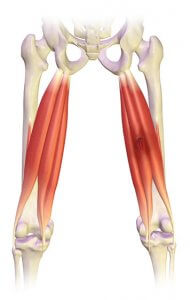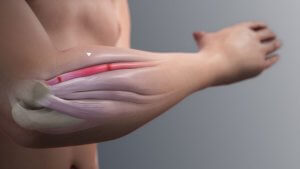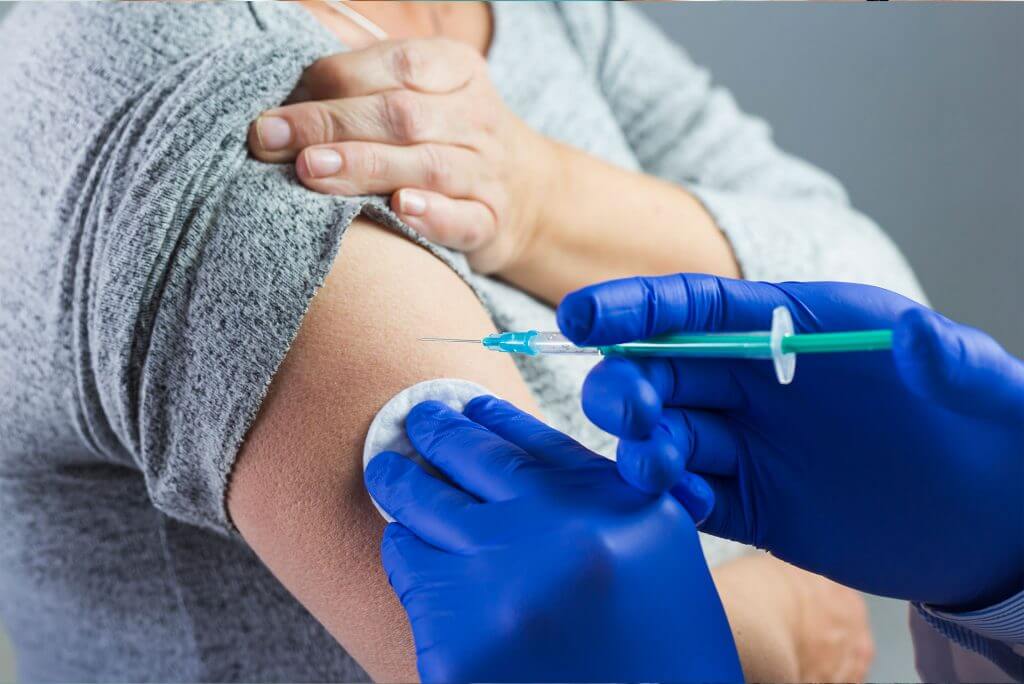So how good is the PRP injection?
So if we have this thing, the platelet, that our body is making anyway and it kicks off the wound healing process naturally then why not put a big glob of it into tricky injuries to get them healing? Well at the moment the reason why not is, it just doesn’t seem to be helping much. We have a few trials so far and individually there has been some success but when we pool the data together to look at, it’s not a glowing review for a PRP injection.
Hamstring injuries

By BruceBlaus [CC BY-SA 4.0 (http://creativecommons.org/licenses/by-sa/4.0)], via Wikimedia Commons
Knee arthritis
Knee arthritis has also been reviewed, the wear and tear kind. This might be an okay avenue to explore, no one is claiming PRP injection is healing this kind of injury yet but it has been shown to reduce pain levels. This might help our ageing population get around a little easier so it’s worth thinking about, but probably only after other avenues have failed. The only problem is that there seemed to be a bit of a risk of bias in these trials, due to financial conflicts. The researchers conducting the trials were paid to do so to some extent by the PRP machine manufacturers. This is not necessarily bad; it just might have influenced the outcomes.

By www.scientificanimations.com (http://www.scientificanimations.com/wiki-images/) [CC BY-SA 4.0 (http://creativecommons.org/licenses/by-sa/4.0)], via Wikimedia Commons
Lateral epicondylitis
What about tennis elbow? Also known as lateral epicondylitis, the bane of the racquet sport athlete and keyboard slave alike. In this case it turns out there is strong evidence AGAINST the use of the PRP as it almost certainly won’t help and can have the potential for harm. In this case we would have to recommend against PRP injections. The only good thing the authors of this study could say was a PRP injection was better than a cortisone injection, but we know cortisone is definitely bad for tendon healing because it makes them much weaker. A simple analogy might be, “getting hit by a push bike is better than getting hit by a car, but it’s still bad.” It’s just that it’s less bad.
Achilles Tendinopathy
Lastly comes achilles tendinopathy, and if you check out my blog, you can find what I recommend for this. But we find no really good results for patients at the 6 month and twelve month follow up.
So what do we have to say about a PRP injection overall?
There are some studies showing benefits, that’s undeniable, but grouping the data and taking a broader look shows very little upside to this sort of treatment. Maybe our bodies automatically select the best amount of platelets for any injury we get, maybe we just don’t need more, who knows? The subject would benefit from some more exacting trials, it may be that we’ll see better results if we only look at fresh injuries, after all platelets tend to clump on new breaks in tissue.
Whatever the reason it’s still pretty safe to say you should try a rehab program first for all the conditions we’ve gone through in this article. But if you stick to your rehab, go to your appointments and do your exercises and you still don’t get any relief then maybe you can look into this subject.
I’ll finish off with a quote from an Australian sports med doctor and world renowned sports scientist, Dr Karim Khan, who has said, “My sense is that the popularity of platelet-rich plasma (PRP) is increasing independent of research in this field.”, i.e. maybe some of the treatments being sold to people out there aren’t as strongly recommended in science as they could be.
References:
- Platelet-rich plasma does not enhance return to play in hamstring injuries: a randomised controlled trial
Bruce Hamilton, Johannes L Tol, Emad Almusa, Sirine Boukarroum, Cristiano Eirale, Abdulaziz Farooq, Rodney Whiteley, Hakim Chalabi - Strong evidence against platelet-rich plasma injections for chronic lateral epicondylar tendinopathy: a systematic review
de Vos R, Windt J, Weir A, Br J Sports Med Published Online First: 21 February 2014 - Efficacy of platelet-rich plasma injections in osteoarthritis of the knee: a systematic review and meta-analysis
Laudy ABM, Bakker EWP, Rekers M, et al, Br J Sports Med Published Online First: 21 November 2014. - Platelet-Rich Plasma Injection for Chronic Achilles Tendinopathy A Randomized Controlled Trial
de Vos RJ, Weir A, van Schie HTM, Bierma-Zeinstra SMA, Verhaar JAN, Weinans H, Tol JL.. JAMA. 2010;303(2):144-149. - One-Year Follow-up of Platelet-Rich Plasma Treatment in Chronic Achilles Tendinopathy
Suzan de Jonge, MD, Robert J.de Vos, MD, PhD, Adam Weir, MD, Hans T. M. van Schie, DVM, PhD, Sita M. A. Bierma-Zeinstra, PhD, Jan A. N. Verhaar, MD, PhD, Harrie Weinans, PhD, Johannes L. Tol, MD, PhD,The American Journal of Sports Medicine Vol 39, Issue 8, pp. 1623 – 1630

Hi, I’m Michael; Chiropractor, Dad, science enthusiast, active weightlifter and keen sportsman. I work with busy and active people who are struggling with pain to find relief from their symptoms so that they can return to an active lifestyle, get through their work day and their workouts without having to pop a pill so that they can feel happier and healthier in their body.

